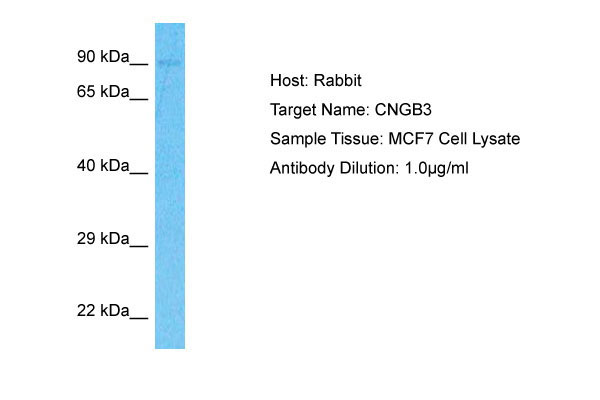CNGB3 Antibody - N-terminal region
Rabbit Polyclonal Antibody
- 产品详情
- 实验流程
- 背景知识
Application
| WB |
|---|---|
| Primary Accession | Q9NQW8 |
| Other Accession | NP_061971 |
| Reactivity | Human |
| Host | Rabbit |
| Clonality | Polyclonal |
| Calculated MW | 92167 Da |
| Gene ID | 54714 |
|---|---|
| Alias Symbol | CNGB3, |
| Other Names | Cyclic nucleotide-gated cation channel beta-3, Cone photoreceptor cGMP-gated channel subunit beta, Cyclic nucleotide-gated cation channel modulatory subunit, Cyclic nucleotide-gated channel beta-3, CNG channel beta-3, CNGB3 |
| Format | Liquid. Purified antibody supplied in 1x PBS buffer with 0.09% (w/v) sodium azide and 2% sucrose. |
| Reconstitution & Storage | Add 50 &mu, l of distilled water. Final Anti-CNGB3 antibody concentration is 1 mg/ml in PBS buffer with 2% sucrose. For longer periods of storage, store at -20°C. Avoid repeat freeze-thaw cycles. |
| Precautions | CNGB3 Antibody - N-terminal region is for research use only and not for use in diagnostic or therapeutic procedures. |
| Name | CNGB3 {ECO:0000303|PubMed:37463923} |
|---|---|
| Function | Pore-forming subunit of the cone cyclic nucleotide-gated channel. Mediates cone photoresponses at bright light converting transient changes in intracellular cGMP levels into electrical signals. In the dark, cGMP levels are high and keep the channel open enabling a steady inward current carried by Na(+) and Ca(2+) ions that leads to membrane depolarization and neurotransmitter release from synaptic terminals. Upon photon absorption cGMP levels decline leading to channel closure and membrane hyperpolarization that ultimately slows neurotransmitter release and signals the presence of light, the end point of the phototransduction cascade. Conducts cGMP- and cAMP-gated ion currents, with permeability for monovalent and divalent cations. |
| Cellular Location | Cell membrane; Multi-pass membrane protein |
| Tissue Location | Expressed specifically in the retina. |
For Research Use Only. Not For Use In Diagnostic Procedures.
Provided below are standard protocols that you may find useful for product applications.
BACKGROUND
Visual signal transduction is mediated by a G-protein coupled cascade using cGMP as second messenger. This protein can be activated by cGMP which leads to an opening of the cation channel and thereby causing a depolarization of rod photoreceptors. Induced a flickering channel gating, weakened the outward rectification in the presence of extracellular calcium, increased sensitivity for L-cis diltiazem and enhanced the cAMP efficiency of the channel when coexpressed with CNGA3 (By similarity). Essential for the generation of light-evoked electrical responses in the red-, green- and blue sensitive cones.
REFERENCES
Kohl S.,et al.Hum. Mol. Genet. 9:2107-2116(2000).
Nusbaum C.,et al.Nature 439:331-335(2006).
Sundin O.H.,et al.Nat. Genet. 25:289-293(2000).
Shuart N.G.,et al.Nat. Commun. 2:457-457(2011).
Rojas C.V.,et al.Eur. J. Hum. Genet. 10:638-642(2002).
终于等到您。ABCEPTA(百远生物)抗体产品。
点击下方“我要评价 ”按钮提交您的反馈信息,您的反馈和评价是我们最宝贵的财富之一,
我们将在1-3个工作日内处理您的反馈信息。
如有疑问,联系:0512-88856768 tech-china@abcepta.com.























 癌症的基本特征包括细胞增殖、血管生成、迁移、凋亡逃避机制和细胞永生等。找到癌症发生过程中这些通路的关键标记物和对应的抗体用于检测至关重要。
癌症的基本特征包括细胞增殖、血管生成、迁移、凋亡逃避机制和细胞永生等。找到癌症发生过程中这些通路的关键标记物和对应的抗体用于检测至关重要。 为您推荐一个泛素化位点预测神器——泛素化分析工具,可以为您的蛋白的泛素化位点作出预测和评分。
为您推荐一个泛素化位点预测神器——泛素化分析工具,可以为您的蛋白的泛素化位点作出预测和评分。 细胞自噬受体图形绘图工具为你的蛋白的细胞受体结合位点作出预测和评分,识别结合到自噬通路中的蛋白是非常重要的,便于让我们理解自噬在正常生理、病理过程中的作用,如发育、细胞分化、神经退化性疾病、压力条件下、感染和癌症。
细胞自噬受体图形绘图工具为你的蛋白的细胞受体结合位点作出预测和评分,识别结合到自噬通路中的蛋白是非常重要的,便于让我们理解自噬在正常生理、病理过程中的作用,如发育、细胞分化、神经退化性疾病、压力条件下、感染和癌症。






